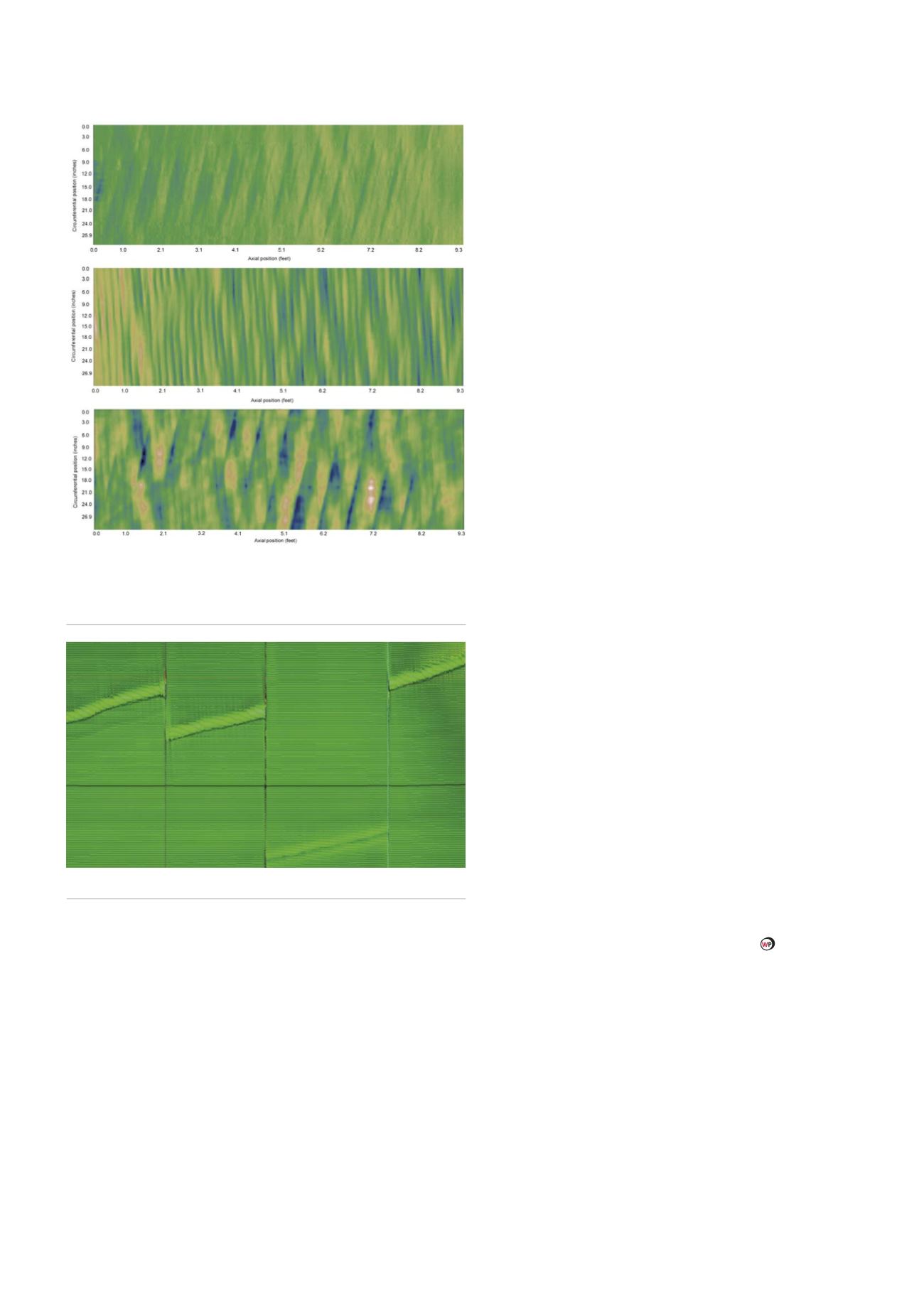
Solving tough integrity challenges
The issues are hardly insurmountable. However, the ILI industry
is successfully applying learning models to solve challenging
problems every day.
For example, when there was no general sizing model to
apply to SSWC, and dents with gouges from coincidental
corrosion – specific pipeline threats with small populations
and unique characteristics – TDW developed two separate
learning models to classify them.
5,6
The models were based on
strategically engineered features only available in the MDS data
sets; when applied to the outliers in pipeline A, they predicted
a 99% probability of SSWC and correctly classified both
dents as having associated gouging. By focusing the model’s
objective on specific anomalies, it was possible to create
adequate input features, which shrunk the prediction space,
improved predictions, and ultimately gave operators a more
comprehensive way to prioritise mitigation plans and manage
pipeline integrity.
ML is also being applied to help pipeline operators comply
with current regulations that require the material properties of
joints of pipes to be traceable, verifiable and complete.
Pipelines with incomplete documentation are a perfect
problem for unsupervised ML – that is, where the model
receives input for each example and attempts to discover
the structured patterns within the data set on its own. MDS
ILI using high field MFL, axial low field magnetic flux leakage
(LFM), and high-resolution profilometry deformation (DEF),
can match joints of pipe by using the signals from patterns
in permeability and bore variations created during the
manufacturing process.
As Figure 4 illustrates, each data set has distinctive
markings and patterns consistent with other joints made
from the same material and manufacturing process. SMFL,
which is sensitive to axial features such as long seam welds,
can also be used to match joints of pipe. Seams made from
the same manufacturing process will generate similar signals,
while features for the seams will be different than for the pipe
body (Figure 5). The variability in the seam welding process
compared to steel rolling and forming often means the criteria
for similarity must be adjusted. Knowledge of the real-world
factors – in this case, knowledge about seam welded pipe
manufacturing – is essential to developing a good ML model.
Protecting pipelines
Protecting consumers against fraud and pipelines from
integrity issues may seem lightyears apart, at least in terms of
how severe a lapse might be. After all, the problems associated
with a stolen credit card tend to be more annoying than
anything, which is a far cry from the risk of a pipeline leak or
other failure.
But just as the banking industry and many others are
benefitting from the strengths of ML applications, so is ILI. The
ability to focus models on specific threats, use subject matter
experts to tailor input features and leverage multiple data sets,
will help keep pipelines the safest transportation method. The
continued advancement and practical utility of future ILI ML
will depend largely on the availability of more high-quality
data sets, coupled with close collaboration between data
scientists and highly skilled pipeline engineers.
References
1.
ATHERTON, D.L. and DALY, M.G., ‘Finite element calculation of magnetic flux
leakage detector signals,’ NDT International, Vol. 20, No. 4, (1987), pp 235-238.
2. YANG, S., SUN, Y., UPDA, L., UPDA, S. and LORD, W., ‘3D Simulation of Velocity
Induced Fields for Nondestructive Evaluation Application,’ IEEE Transactions on
Magnetics, Vol. 35, No. 3, (1999), pp 1754-1756.
3.
NESTLEROTH, J.B., RUST, S.W., BURGOON, D.A. and HAINES, H., ‘Determining
Corrosion Defect Geometry from Magnetic Flux Leakage Pig Data,’ Corrosion96
(March 1996), NACE-96044.
4. BUBENIK, T. A., NESTLEROTH, J.B., DAVIS, R. J., CROUCH, A., UPDA, S. AND
AFZAL, A. K., ‘In-line Inspection Technologies for Mechanical Damage and SCC in
Pipelines: Final Report,’ US DOT, OPS, (2000).
5. NESTLEROTH, B. J., SIMEK, J. AND LUDLOW, J., 2016, ‘New Classification Approach
for Dents with Metal Loss and Corrosion Along the Seam Weld,’ Proceedings of
the 2016 11
th
International Pipeline Conference (2016), p. 10.
6. ANDREW, J. and SIMEK, J., United States of America Patent No. US 2019/0162700
A1 (2019).
Figure 5.
SMFL data taken for joints with different seam welds.
Figure 4.
Top: the measured magnetism of a joint of pipe
using high field axial magnetisation. Centre: using low field
magnetisation. Bottom: high resolution measurements of the
radial distance to the inner surface of the pipes.
62
World Pipelines
/
MARCH 2020








